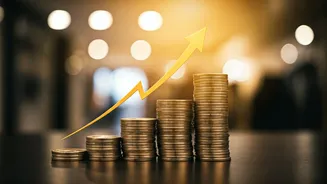October's GST Growth
The GST collections for October presented a growth of 4.6%, reflecting a positive trend in the Indian economy. This increase follows GST 2.0 rate cuts,
prompting analysts to examine the sustainability of collections. Various experts weighed in on the performance. Vivek Jalan of Tax Connect Advisory Services mentioned that the 0.6% growth confirmed that boosted consumption somewhat balanced revenue declines from the rate cuts, aided by pent-up demand. Mahesh Jaising of Deloitte India referred to it as the 'GST utsav dhamaka.' The surge was significant, with a total revenue of ₹1.96 lakh crore, highlighting the economy's resilience amid festive momentum and compliance improvements. Moreover, Saurabh Agarwal from EY India said the lag in spending in September was compensated by more robust figures the following month due to seasonal buoyancy.
Factors Behind Growth
Several factors contributed to the GST collection increase. Festive demand played a key role, stimulating consumer spending and boosting collections. Moreover, the implementation of lower tax rates in certain sectors also influenced consumption patterns. Analysts point out that despite rate reductions, the demand remained strong, a sign of a robust economy. MS Mani of Deloitte India noted that the marginal growth was due to postponed supplies from September and the impact of lower rates, especially on automobiles. Pratik Jain of Price Waterhouse & Co LLP echoed this, stating that the slight increase, even with massive rate cuts, was encouraging and indicated steadily increasing demand. Furthermore, the withdrawal of most compensation cess also had an impact. The focus on addressing working capital issues for exporters and businesses affected by inverted duties also contributed to investor confidence.
Expert Insights and Concerns
While the October numbers reflected positive trends, experts also voiced concerns and offered insights. Manoj Mishra of Grant Thornton Bharat suggested that the October figures validated India's recovery momentum. Karthik Mani of BDO India stated that domestic transactions remained flat with only 2% year-on-year growth, adding that some discretionary purchases were delayed. Furthermore, several experts, including Sivakumar Ramjee of Nangia Andersen LLP, highlighted the need for careful consideration of state-level disparities. He mentioned that Maharashtra remained the largest contributor to collections, while Gujarat showed resilience, and Karnataka and Tamil Nadu benefited from tech and industrial revival. There's also caution regarding the potential impact of lagged effects of rate cuts on less formalised economies, particularly in the weaker states. Experts said that the expected surge in refund outflow may soften net revenues.
Looking Ahead: November
November is viewed as a crucial month for evaluating the long-term impact of the GST 2.0 rate rationalization and shifting duty structures. Analysts suggest that the collections for November are likely to be higher, as the impact of rate reductions should be offset by increased supply volumes. The focus is on how well collections can sustain amid the changes. Agarwal indicated that the full impact of rate cuts will reflect in next month's data, which 'would be keenly awaited.' The data from November will provide a clearer picture of post-rationalization demand. November's performance will be a crucial indicator for India's economy. The interplay between consumption, compliance, and structural reforms continues to shape the GST landscape, offering valuable insights into the nation's economic trajectory.
















